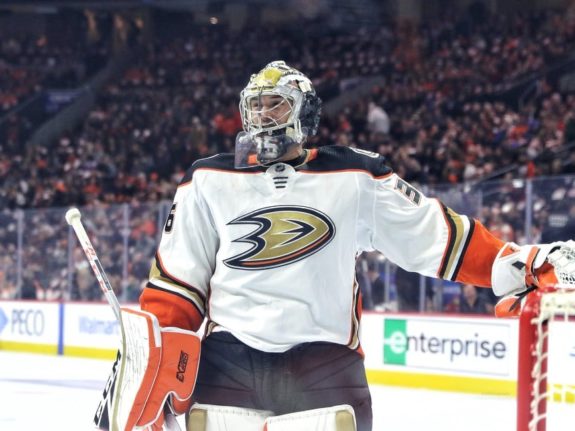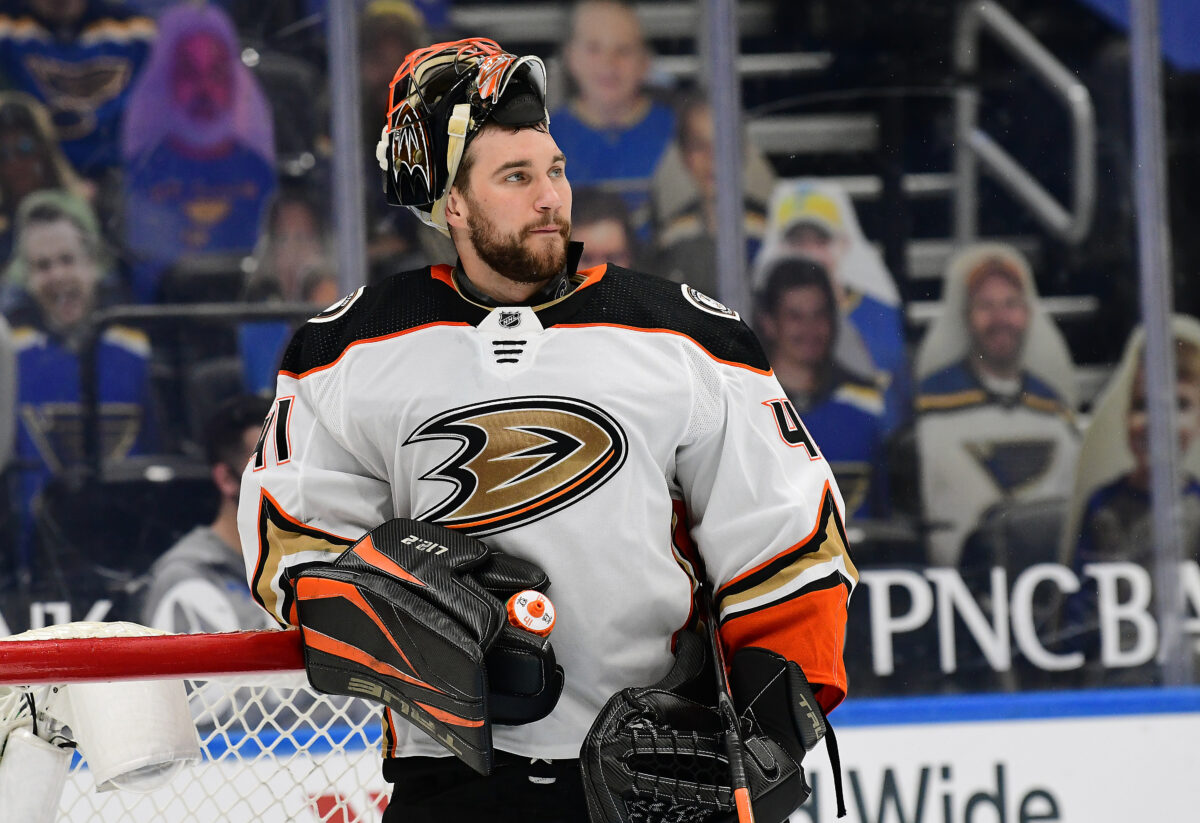The Anaheim Ducks‘ 2020-21 season has finally — and mercifully — come to an end, and the team finds themselves at the bottom of the pile. Second to bottom of the pile, if you want to get extremely specific. Of course, with the conclusion of the season comes an overview of how the players fared during said season. My colleague Eddy Jones and I decided to split up the grades by position for length and clarity sake. We also set a games-played requirement of 10, but made an exception for goaltenders.
John Gibson
2019-20 Season: 20-26-5 record, .904 save percentage (SV%), 3.00 goals-against average (GAA) in 51 games played (GP)
2020-21 Season: 9-19-7, .903 SV%, 2.98 GAA in 35 GP
Analysis: John Gibson has reached the point of his career where any performance short of spectacular is deemed as an “off night.” The Pittsburgh-native has been the backbone of the team ever since becoming the full-time starter in 2017, and when it comes down to it, the Ducks probably depend on him to bail them out more than they should have to.
It was far from a stellar season for Gibson, but the entire team was less than stellar over the course of 2020-21. He still finished with the highest point shares (PS), an estimate of the number of points contributed by a player, on the team with 5.6. No one else came close to matching his total with the next highest amount being Cam Fowler with 4.2 and then Max Comtois at 4.0.

Sure, Gibson’s goals saved above average (GSAA) has plummeted into the negative region the past two seasons, but it would be unfair to pin the Ducks’ inability to keep the puck out of their own net on their star netminder. This was just the first since his debut season that he failed to reach double-digit wins. This is more of an indictment on the team’s performance as a whole rather than just their goaltender. It was clear to see at some points during the season that he was frustrated with how the team in front of him was performing.
With the Ducks mired in a “re-tooling” phase, next season may be the final tipping point for Gibson if the team is still mired in the cellar of the standings. He will be just 28 years of age next season and it wouldn’t be a far-away notion to assume that he is just hitting his prime. In the past, we’ve seen instances of players in their prime ask out of rebuilding situations in order to force a move to a playoff contender. Could he be doing the same in the near future? It’s unlikely at the moment, given that the 27-year-old expressed his desire to remain in Anaheim during his exit interview. However, it’s something to be mindful of if the downward trend of the team continues into next season.
Grade: B
Ryan Miller
2019-20 Season: 9-6-4, .907 SV%, 3.10 GAA in 23 GP
2020-21 Season: 4-8-2, .882 SV%, 3.51 GAA in 16 GP
Analysis: It feels a bit melancholy to give Ryan Miller anything lower than a “D” rating given what he’s been through over the past year, but the 40-year-old was pretty dreadful this season. Father Time clearly flexed its muscles when it came to how he performed in goal as the former Vezina Trophy winner posted the worst numbers of his career.
He played so poorly that head coach Dallas Eakins had no issue with giving third-string goaltender Anthony Stolarz a handful of starts as the season began to wind down. The fact that Miller had as many really bad starts (RBS) — starts with a save percentage (SV%) below 85 percent — as he had wins is telling.
Miller was a serviceable backup for Gibson for a number of seasons, but he just didn’t quite have it in his final season. Now that he has hung up the skates for good, he can spend more time with his family, and it’s probably for the best.
Grade: D
Anthony Stolarz
2019-20 Season: 0-1-0, .944 SV%, 2.05 GAA in 1 GP (with Anaheim); 21-12-8, .922 SV%, 2.66 GAA in 39 GP (with San Diego)
2020-21 Season: 4-3-0, .926 SV%, 2.20 GAA in 8 GP
Analysis: Stolarz spent a majority of the season on the Ducks’ taxi squad while Lukas Dostal and Olle Eriksson Ek held down the net for the San Diego Gulls, the team’s AHL affiliate. Due to the unique nature of the season, Stolarz being the third-string goalie meant that he could not be shuttled back and forth between the Ducks and Gulls.
But once Stolarz got his chance, he never looked back. A relief appearance in a 5-1 loss to the Arizona Coyotes was a rude awakening to the 27-year-old in his season debut as he let in a goal on the first shot that he faced. He bounced back a week later in his first start of the season, stopping 38 of 40 shots en route to a 3-2 overtime win. He even had the primary assist on Josh Manson’s game-winning goal.
Five quality starts in seven games started is quite impressive, especially given the quality of the Ducks’ blue line this past season. Injuries to Hampus Lindholm and Manson along with a mediocre debut season from Kevin Shattenkirk meant that the team was icing a shorthanded defensive corps more often than not. Stolarz was also the only Ducks goaltender to register a positive GSAA (4.2).
In fact, Stolarz played so well that he earned a spot on Team USA’s 2021 IIHF World Championship roster. However, he suffered a lower-body injury during the first game of the tournament and was ruled out for the remainder of the competition. There’s been little news on his injury since its occurrence other than that he would return to the United States for further evaluation. Hopefully, it’s not something too serious.

It’s possible that Stolarz’s performance this season may have earned him a one-way ticket to Climate Pledge Arena and the Seattle Kraken, but there are many goaltending options besides the former Philadelphia Flyer that the Kraken will be able to choose from. If the Ducks escape with their goaltending unscathed, it should be a straightforward decision to plug in Stolarz as the backup, replacing the departed Miller.
Grade: A
Goaltending should continue to be a strength for the Ducks next season, given Gibson’s usual stellar play and the emergence of Stolarz. If the rest of the team improves its play, next season should look a lot more positive than this past season.